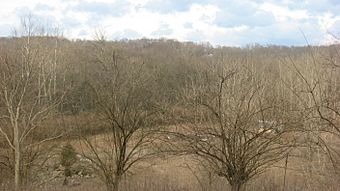Dravo Gravel Site facts for kids
Quick facts for kids |
|
|
Dravo Gravel Site
|
|

Overview of the site
|
|
| Lua error in Module:Location_map at line 420: attempt to index field 'wikibase' (a nil value). | |
| Nearest city | Cleves, Ohio |
|---|---|
| Area | 7 acres (2.8 ha) |
| NRHP reference No. | 78002083 |
| Added to NRHP | December 22, 1978 |
The Dravo Gravel Site (also known as 33HA377) is an important archaeological site in Hamilton County, Ohio, United States. It's located near the Great Miami River. This site gives us a lot of information about the Archaic period in this area. It was discovered in a gravel pit.
Contents
Discovering the Ancient Site
The Dravo Gravel Site is found on a flat area, or terrace, above the Miami River. This spot was good for ancient people because it had a small stream for water. They didn't have to climb all the way down to the river.
A company called Dravo Corporation had a large gravel pit here. When the site was found, archaeologists had to work quickly. They did a salvage excavation. This means they dug up artifacts to save them before the gravel operations continued. Because of this, they couldn't explore the whole site.
What Archaeologists Found
Even with a quick dig, archaeologists found many interesting things. They discovered groups of features. These were usually pits used for cooking or for throwing away trash. The experts think each group of pits was used by a different family.
They noticed that the trash pits were always covered with soil after being used. This suggests that the ancient people cared about keeping their living areas clean. They buried their garbage instead of leaving it out in piles.
Burials and Tools
Archaeologists also found human remains at the site. Ten bodies were discovered, ranging from a young girl to a woman in her late thirties. Two dog burials were also found, which is special for sites in this region.
Some of the bodies were buried with tools like scrapers or other stone tools. Others had animal bones and teeth buried with them. Many more stone tools were found throughout the site. These included axes, parts of atlatls (spear throwers), pestles, and celts.
How Old is the Dravo Site?
The Dravo site covers about 2.3 hectares (about 5.7 acres). To figure out its age, scientists used a method called radiocarbon dating. This method helps determine how old organic materials are.
The results for the Dravo site showed it was from around 500 BC. This date was much later than other similar sites in the area. For example, the nearby Bullskin Creek Site is over two thousand years older. Based on the types of tools found, experts believe the people who lived at Dravo were from the middle of the Late Archaic Period.
A Protected Historical Place
In 1978, the Dravo Gravel Site was added to the National Register of Historic Places. This means it's recognized as an important historical or archaeological site. This listing helps protect the site because of its archaeological importance.

